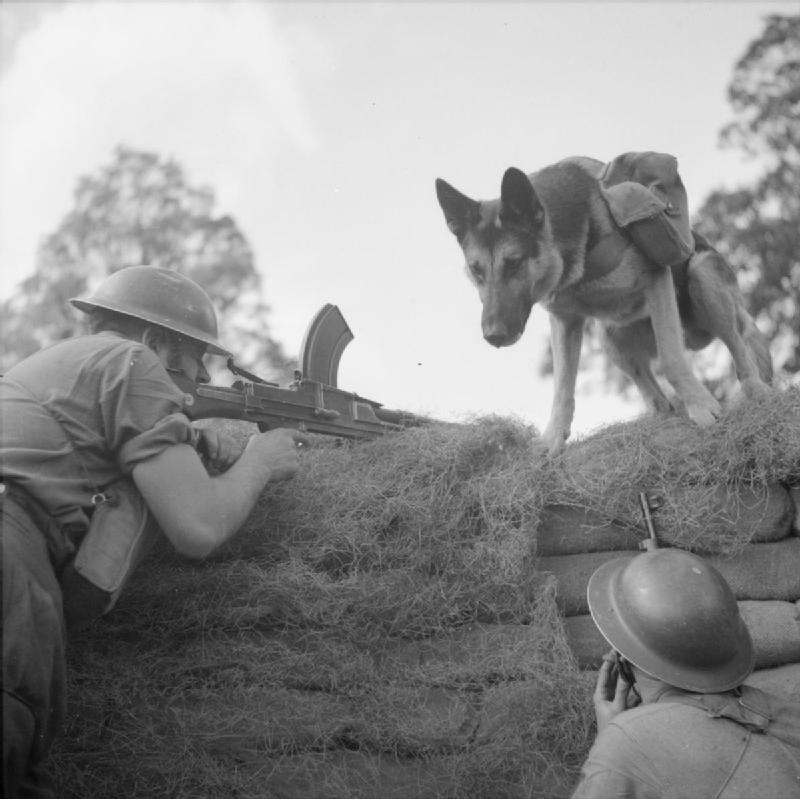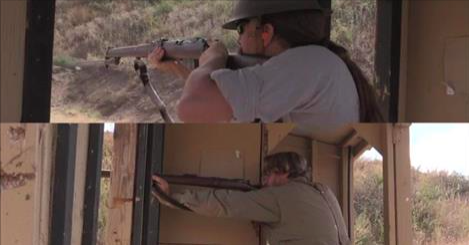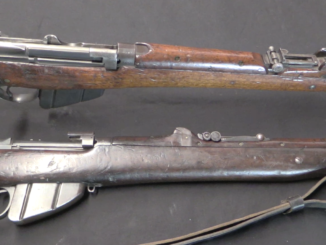
Mark (a dog ammunition carrier) delivers ammo to a Bren gun team, Eastern Command 20 August 1941.

Mark (a dog ammunition carrier) delivers ammo to a Bren gun team, Eastern Command 20 August 1941.

Courtesy of reader Robert, we have a couple documents for you today. First up is a British 1918 manual on identifying different types of ammunition by projectile, case, and packaging markings. Given the variety of […]

This is the second of our two videos from the most recent 2-Gun match, which was designed with an explicit World War One theme. This one is a head to head match between me, kitted […]

One of the British lessons form the Boer War was that the distinction between infantry rifles and cavalry carbines was becoming obsolete. In 1902, they would initiate troop trials on a new short rifle pattern, […]
© 2025 Forgotten Weapons.
Site developed by Cardinal Acres Web Development.

Look how far that rear sight is jacked up.
I wonder how much ammo they would heap on a dog?
The fellow on the right is holding a Pattern 1914 Enfield judging by that distinctly American front iron sight. Just where are we at this point in history?
“Mark, no treats until those baddies are all dead.”
[Mark whines in disappointment]
I don’t know about issuing Pattern 14 rifles in WW2 to British forces but I know its derivation – M1917 Enfield was used and captured by German forces and renamed Gewehr 250(e).
According to: http://en.wikipedia.org/wiki/M1917_Enfield
“Many were bought by the United Kingdom through the British Purchasing Commission for use by the Home Guard; 615,000 arrived in Britain in the summer of 1940, followed by a further 119,000 in 1941.[9] These were prominently marked with a red paint stripe around the stock to avoid confusion with the earlier P14 that used the British .303 round”
It seems a bit odd that the dog appears to be coming into the gun position facing into the general direction of defensive fire rather than from behind that position, although there may be extenuating tactical circumstances involved. Still, this would indicate what is probably a posed photo-op.
Work in progress, he he…
Might have work worked better with a more appropriate, imaginative dog name like fido or something. “Mark, Mark come here!” The dogs like, who me or Mark, Mark? Me? Alright then. No Mark don’t come this way, go behind Mark. Woof, what?
Probably security, saying Fido would alert the Gerry to look out for a dog.
As if the Germans didn’t already panic at the sight of stray dogs on the Eastern Front due to some stupid Soviet ideas involving dogs, explosives, and lack of information about whether the suicide dog was even a good idea to begin with…
I think I once heard of British WW1 idea to use Herring, or seagulls, or a combination of both, I’ll try and find it he he.
Regarding dogs used by Soviets for specific purpose of carrying explosive charges to tanks, I have heard that. Actually it was from my own father (he was not involved in fighting during WWII) – he might have heard it from someone in turn. How much it was true or not I could not tell, but extreme circumstances require extreme measures.
The troops are very clean, as is the position. Nothing out of place at all. No mess or disorder, and the sandbags are uniform and intact, no torn burlap at all. So, staged photo, or taken during training. Quite remarkable idea, canine ammo bearers, though.
Hi, Kevin :
Good to hear from you again, and I do agree with your assessment.
Hope all is well with you and yours, and that you are having a good summer! 🙂
And Mark’s puppies would be Mark I, II, etc.?
Ha ha, quite.
Well, in August 1941, the only place where British were fighting was North Africa where there was an acute lack of logs to construct bunkers. There were sufficient stones in the desert to make sangurs.
tThis obviously posed photo probably appeared once before the ‘pet-loving’ British public protested.
Pdb: I have read that the RN smeared periscopes of their subs with herring oil to attract seagulls.
Yes it worked and the seagulls mobbed the periscopes. But German periscopes did not smell like herring oil.
The dogs with the ‘suicide jacket’ (sound familiar?) were trained to crawl under a tank, and be sent to heaven- or at least a piece of scarce meat – with 72 virgin bitches) using proven training methods devised by the Russian Pavlov.
Upon release, they zeroed in on the sound of the Soviet V12 diesel engine and totally ignored the German Maybach V8 engine sound.
Cheers
Well that was rotten bad luck, if that was it.
I think we were fighting elsewhere at that time Thomas, ze Nazis weren’t so hard when we snapped the remainders necks in 45 etc.
Speaking of suicide animals, there was a secret project to release bats (with incendiaries strapped to them) over Japanese cities. The idea being that they would find nooks and crannies to go to sleep in, then fires would break out all over said town. It would have been a very efficient means for one bomb to incinerate a lot of structures. The project went along until some bats got loose and burned down the secret air base, that was the end of it. The landing strip for the base in south east New Mexico remained for years thereafter until drug runners started using it, then it got plowed up twenty or thirty years ago.
That’s really interesting, Jacob — thanks for sharing. Talk about “backfires”!
Here is a link if you’re interested: http://www.elpasotimes.com/news/ci_25839548/an-idea-so-idiotic-it-could-possibly-work
….Eastern command is in the eastern counties of Britain, not overseas. It is headquartered in London. This is a staged photo . In August 1941 Britain was under air attack and the treat of invasion.
Hi there my spouse! I must say that this information is amazing, terrific composed and may include just about all significant infos. I will notice extra blogposts like that .
Bonus canus!
Interesting photo. Czech design machine gun, US made copy of German Mauser and a German dog. Wonder if the 2 guys are English?
It’s even more interesting, as the rifle, the Enfield M1917, is a US copy of the British copy of the German rifle. The “US copy of Mauser’ would be the M1903 Springfield. It’s like Jericho pistol – an Israeli copy of the Italian copy of the CZ-75. Welcome to the globalized world…
Well, the Italian copy of the CZ was made under license. Not sure about the Jericho.
The M1903 was a knock-off without a license — until Mauser sued. The US either lost or settled and paid royalties up till the US entry into the Great War. I dunno if Mauser ever sued Arisaka, but that’s another copy…
I’d like to add, Leszek and gang, that the way firearms designs spread across the world has always been fascinating. (Look at the impact of Mauser’s C96 and all of Browning’s pistols on subsequent designs). There is a definite similarity in military technology that is driven by convergent evolution as well as by copying.
In 1770, every military power in the world issued some kind of smoothbore flintlock musket of cal. .50-80.
In 1860, every military power in the world issued some kind of percussion rifle-musket of slightly smaller caliber.
By 1880, they issued single-shot cartridge rifles of slightly smaller, again, caliber (.40 to .55 or so).
By 1910, they issued turnbolt repeaters holding five rounds of .25-.35 cal. smokeless ammunition in a fixed magazine. Most of them were still issuing these guns in 1945, although supplemented by other weapons in the infantry company, platoon and squad. (That was a big change. Before WWI an infantry company was a few pistol armed officers leading ~100 guys armed with identical rifles). Every nation experimented with semi-auto rifles in this period, but only the US went all in and stayed all in. (Russia went all in, then backed off. If you hold an M1 and an SVT you will see why).
By 1960, they issued semi-auto or select-fire rifles firing about the same cartridge (ballistically speaking) from a 20-round detachable magazine. Only the Russians really followed up on German intermediate cartridge developments at that time.
By 1980, a <6mm cartridge in a smaller selective fire platform was marching through the world's services, and
By 2000, everyone was looking at modularity; by 2010, they were executing.
If you look at other military technology you see similar evolution. Consider the warplane. In 1914 it was a spidery box kite, by 1918 a 100-knot open-cockpit biplane armed with two synchronized MGs, by 1940 a low-wing enclosed monoplane with more larger-caliber MGs or cannon, powered usually by a 60º V-12 engine with one or more superchargers, or a large twin-row radial with supercharger. Everywhere in the world!
Everyone seems to wind up with what works (i.e. the Mauser bolt design had engineering and industrial strengths over those that came before; everyone in the world seems to be going to modular systems with accessory rails now, etc.)
An excellent and astute summary — thanks for sharing!
There is one non-scientific name for it – cross pollinating. I was gonna say “monkey se-monkey do” buy that might be less than dignifying.
Actually, one thing to consider is that ‘nobody’ from major players wanted to be ahead by larger leap than necessary. There were always reasons for that. One of them of course is: where would you get heroes, if dying was done only by other side?
Was it Tanfoglio?
http://en.wikipedia.org/wiki/Tanfoglio_T95
The debt of Israeli Galil to Kalashnikov is commonly acknowledged.
What is less acknowledged is the debt of Uzi to the Czech submachine gun.
Regards, Andrzej
Wouf. . .wouf. . ! ! ! !
What a cute dog! Is it a husky?
No, I think he’s a German Shepherd… I could be wrong.
I believe after the outbreak of hostilities, the breed’s name in the U.K. was changed to Alsatian Shepherd, to reduce the Teutonic stigma.
Oh dear!
Andrew, since the unpleasantry of 1939-45, the politically correct term is ‘Alsatian’. Mind, Alsace
was swapped between France and Germany 5 times between 1871 and 1945 and, in 1941, the fictitious canine ammo carrier would have been a German shepherd.
Agreed, except for the U.S. The breed has nearly always been commonly referred to over here by all and sundry as a German Shepherd, although if you say “Alsatian”, people will also instantly understand that you are talking about a German Shepherd.
.1 I also remember the post-war period in Poland when these dogs were referred to as Alsatians – now they are called German Shepherds. Many practices were the result of the (then) recent monstrous war. But there also may have been French cultural imperialism involved (incidentally, in English one says “to take a French leave”; in French one says” filer a l’anglaise’). For pre-war period I rely on my late uncle, who told me that before the war he had had a Danish Dogue (also called the Great Dane in English). Now it is called German Dogue. So Alsatian may have also been earlier than Post WWII.
2. Speaking of dogs and tanks, I also read about it. Desperate times call for desperate measures. The most desperate was 1941 – then most of the Soviet tanks had PETROL engines. Granted, the sound they made probably WAS different from MAybach’s.
Regards, Andrzej
Could be a Belgian Malinois. They look like German Shepherds. They’re popular with the U.S. military as bomb sniffing dogs these days.
In Australia, when I was a kid (1950s), these dogs were most commonly known as ‘Alsatians’. The term ‘German Shepherd’ became popular later on, and now one only hears of ‘German Shepherds’. I think the name change was encouraged because here the Alsatian was widely regarded as a savage breed, and the ‘Shepherd’ idea improved the image of the breed to some people.
I remember reading that OSS had thought about releasing booby trapped bats in the Ploesti region to attack the refinery.
yet another reason why this animal is referred to as “mans best friend”. They will LITERALLY cross hell for you.